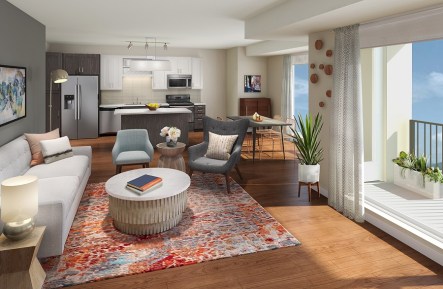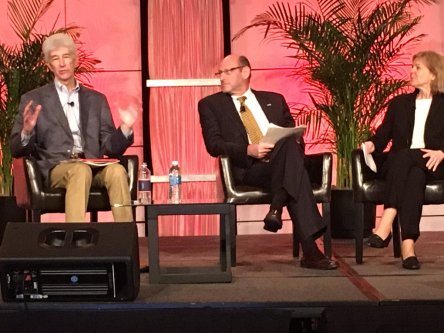In the 2020 National Multifamily Housing Council & Kingsley Apartment Resident Preferences survey, 373,000 residents living in 5,336 communities across the U.S. shared their feedback on what renters want. Millennial renters, particularly college-aged adults, expressed their most desirable features in rental housing. Hot topics for the year included parking, sustainability, health, and security. Amenities in these categories interested more than 50% of respondents. Young renters’ top 10 interests Adult renters ages 25 and under were asked which apartment features and community amenities interested them the most. The following 10 features topped their lists: 91% reliable cell reception 88% swimming pool 87% fitness center 85% controlled amenity access 84% secure, self-service, 24/7 package access 82% more storage space in apartment 83% recycling 79% visitor parking 75% common area grills 75% hot tub “The top three categories here– connectivity, swimming pool and fitness center– speak directly to what is top-of-mind for the typical student renter,” says Esther Bonardi, vice president, marketing at Yardi. “Available Wi-Fi to keep up with assignments and stay on top of their studies, a swimming pool that serves as a social oasis to unwind and relax with their friends, and a fitness center to maintain wellness in the midst of their chaotic schedules.” Bonardi adds, “One difference for students is that connectivity is a major factor in Wi-Fi reliability and speeds rather than cell phone reception. Reliable cell phone reception is a standard or necessity rather than an interest.” Reoccurring themes for college-aged renters It’s no surprise that connectivity is a prominent interest of Millennial renters. More than 91% of respondents listed reliable cell reception as a major interest. Nearly 70% were also interested in having Wi-Fi connectivity in common areas. Parking concerns appeared multiple times on the list of young renters’...
Residents Speak
Reputation Management
A stellar online marketing strategy can be thwarted by negative reviews. The 2020 National Multifamily Housing Council & Kingsley Associates Apartment Resident Preferences Survey reports that 33% of renters highly value online reviews when deciding on an apartment. Are your reviews working for you or against you? Take the four steps below to ensure your online reviews are an asset. Who is paying attention to your online reviews? Renters of all ages use the internet for product research. Renters ages 25-34 years value online reviews the most. Nearly 40% of Millennial renters “highly value” the content of online reviews. While all your residents appreciate good customer service, younger renters are more likely to take their opinions to the web. They’re also more likely to seek out the opinions of others before deciding on a property. While some of the young renters are residents, most are prospects. Curiously, they’re searching out negative reviews. Studies show that since there are more positive reviews than negative ones, negative reviews are given greater value. Low-star reviews are scarce, so they’re held in higher esteem, like rare gems or box seats at a sporting event. That is why dissatisfied residents need extra care. Per the White House Office of Consumer Affairs, dissatisfied customers typically tell nine to 15 other people about their experience in person. The availability of online reviews can quickly escalate their reach. The negative review of a dissatisfied resident will reach hundreds of prospects each day, prospects who are already looking for negative reviews to narrow their apartment options. The four tips below can help you avoid and mitigate negative online reviews while boosting your positive online presence. Resolve issues online before reviews are posted online When renters have a concern, they are going to get online....
In Renters’ Wallets...
5 Most Valued Smart Home Devices
We’ve all heard that renters are interested in smart home devices. How much are they willing to pay for them, though? We dive into the 2020 National Multifamily Housing Council (NMHC) & Kingsley Apartment Resident Preferences Survey to find out. What renters value is determined by how much they are willing to pay. The Resident Preferences Survey set out to put a monthly price on smart home features that renters crave. Nearly 373,000 renters living in 5,336 communities across the U.S. submitted their opinions on desired gadgets and pricing. The 2020 report is the largest compilation of apartment resident insights to date. Let’s take a look at which smart home features are most valuable to renters. Most Valued Smart Home Features All valuable smart home gadgets are connected to the internet of things (IoT). It takes more than internet connection for renters to value a gadget. The survey reveals that the most valuable smart home features are those that offer a combination of benefits in a single gadget. One of the most valuable smart home features makes the unit more comfortable, functional, and healthy. Survey respondents are willing to pay $36 for smart or dynamic glass. The technology helps to moderate indoor temperatures. It also reduces glare on display surfaces like televisions and tablets. Additionally, the dynamic glass promotes better health by blocking harmful light rays from the sun. Smart locks are the second most valuable. This product also multitasks: it offers the convenience of keyless entry as well as a layer of security. Most smartphones are protected with face recognition, fingerprint scanners, or PINs. An authorized user must be present to unlock the phone and then use an app on the smartphone to manage the lock to the unit. Renters are willing to...
The Mobile Advantage
Resident Satisfaction with Mobile Apps
Your resident portal is a convenient and secure connection to your renters. While some renters like to access the resident portal via computer, studies show that most renters prefer to use a mobile app. If your current resident portal doesn’t offer a robust mobile option, you’re missing out on three key points for resident satisfaction. What renters want: convenience and efficiency with a mobile app According to the 2020 National Multifamily Housing Council (NMHC ) & Kingsley Apartment Resident Preferences Survey, community mobile apps are in high demand. Community apps permit a secure and mobile-ready way for users to access resident portals without using a web browser. Renters access mobile apps directly via smartphone or tablet, two devices that most of us always have within reach. In contrast, websites are best viewed via web browser on a laptop or desktop computer, which we don’t always have on hand. A community mobile app can promote renter satisfaction in three distinct ways. Mobile apps improve communication, task management, and daily operations for renters Residents prefer to communicate via mobile app more than conventional methods. About 60% of survey respondents prefer for leasing management to contact them via mobile app. Only 17% prefer contact through the website portal. On average, 64.5% of renters prefer to receive notifications through a mobile app. For example, 71.5% of renters want to receive mail and package notifications through the community mobile app. An app is also a preferred way to manage a household. On average, 58% of respondents prefer to pay rent via mobile app compared to only 23% who want to pay through the website portal. About 64% of renters want to submit maintenance requests via app. Even a formal event, like a lease renewal, is suitable for the app:...
A Match Made in Heaven
Self Storage + Multifamily Housing
The 2020 NMHC & Kingsley Apartment Resident Preferences Survey reports that 71 percent of rural renters and 70 percent of suburban renters ranked “additional storage outside apartment” as a top interest. Many multifamily properties, however, are not equipped with storage units for renters. Self-storage facility managers can fill the gap and benefit from a steady stream of clientele—if you make the right connections. Make an offer they can’t refuse Before the turn of the millennium, additional storage wasn’t as in-demand then as it is now. As a result, many older properties weren’t constructed with storage units for renters. Even some newer properties with storage options don’t have enough to meet demand. Such properties may prove to be your valuable partners. Renters who need storage may find the additional space they need at self storage facilities in the neighborhood. The challenge is to make sure that your storage facility tops their list. You could amplify your online marketing strategy, but that could be costly and time consuming. A captive audience, through a partnership with local apartment communities, could be a much surer path to success. Think about negotiating an incentive or deal for residents in nearby apartment communities. You’re interested in predictable, long-term clients. Multifamily agents want to meet prospects’ and renters’ demands for storage space outside of the unit. There is room for both parties to benefit. “Consider approaching the apartment community with a win-win proposal without a formal monetary reward if there is not another competing storage property within proximity. Pitch your storage property as a neighborhood amenity that the community manager can promote. Only offer a referral bonus if competition forces you to do so,” advises Mark Smith, Director of Marketing with Yardi. He continues, “Storage operators should consider (and continually re-evaluate) their new customer acquisition costs. Make sure that your referral bonus agreement with an apartment community is in line with your normal acquisition costs.” Benefit from verified clients Most multifamily properties vet their residents before allowing them to sign a lease. A verification of employment history, good credit standing, and background checks are quite common. In contrast, very few self-storage facilities require an in-depth approval process. When you create a relationship with an apartment community, you can benefit from their verification process. Multifamily renters go through additional steps that could in turn reduce your exposure to missed payments and other risks. You will still benefit, though, from your own due diligence. “Track all tenants that rented via referral programs and evaluate for ROI,” says Smith. “Are they tenants that have paid their bills and stayed long enough to provide a positive revenue stream, or are you better off terminating the agreement with the apartment community?” Put your best foot forward To secure your position as their preferred vendor, clearly detail what differentiates you from the competition. You then have a platform to confidently state your price because you have demonstrated the value that you can offer to their renters. There are a few key features that renters want in off-site storage. If you offer such features, be sure to highlight them in your proposal: Security In an ideal world, renters would safely store their belongings in their apartment. But with limited space, that isn’t an option. They rely on you to provide additional space that is also secure. Keyless access via a smartphone app or personalized keycodes are popular with renters. (Some use similar technology to access their apartments.) By implementing such tech, you can offer a secure way to access units without the burdens and risks of physical keys. Most renters expect security cameras and gated entry. Offering 24/7 staff availability (or at least extended office hours) adds an appealing layer of security and reassurance during emergencies or other issues. Ease of Use While renters want secure self-storage, they want to access it on demand. This is another place where keyless entry places you...
NMHC Top Managers
Yardi Clients Shine
Online reputation management matters. How masterfully a company handles feedback can give it a huge advantage over the competition as prospects shop around for a new rental. ORA Power Ranking shifted through the online reputations of 75,000 rental properties. The following list represents the National Multifamily Housing Council (NMHC) top 10 best-ranked managers by online reputation. The companies below received the highest ORA scores. For perspective, the national average is 60.39. Each of the companies below ranked 71.58 or higher, earning top marks for online reputation. Yardi client The Bozzuto Group once again took home the first place title. The Bozzuto Group has ranked number one in online ratings for four years. To maintain its ranking, Bozzuto increased its score by 2 percent from last year, improving from an ORA rating of 79.13 to 80.76. That 2 percent was needed to stay ahead of second place performer AvalonBay Communities, another Yardi client. With an ORA score of 80.17, it was a close call for the top two positions. In third place comes Gables Residential. This Yardi client received an ORA score of 76.98. This is a noteworthy, 4 percent improvement for the Atlanta-based company. MAA nips at the heels of Gables Residential with a score of 76.44. Its 3 percent improvement in the ORA score kept the organization in the top five. Rounding out the top five with a stellar performance comes Cortland Partners, a Yardi client. This underdog improved its ORA rating by a whopping 10 percent, reaching 75.20 this year. The following companies complete the top 10 rankings. 6. Camden Property Trust 7. RAM Partners (Yardi client) 8. Pegasus Residential (Yardi cient) 9. Aimco 10. Greystar (Yardi client) Congratulations to all of the NMHC Top 10 Managers, especially our valued Yardi...
Apartment Trends
RENTCAFE Construction Report
We’d need 4.6 million new apartments by 2030 to meet demand for rental living and keep prices in check, reports the National Multifamily Housing Council. That’s about 373K new units each year on average, a number that’s rather optimistic considering the pace of apartment construction in the last decade. So how feasible is this plan? A recent study from RentCafe on the apartment market suggests the country’s growing renter population need not be too concerned. According to data from real estate data provider Yardi Matrix, apartment construction is at a 20-year high, with most of our country’s biggest cities seeing significant upgrades in rental stock. After a slow post-recession period, the market started rebounding in 2012 and by 2014 new supply had amounted to more than 237,000 units delivered in one year, well above historical averages. Between 1997 and 2006, annual completions averaged 212,740 units. In 2017, apartment completions are expected to top 345,000, a 21% increase compared to last year’s deliveries when more than 285,000 units saw the light of day. Hot Urban Markets See Rents Softening as Developers Ramp Up Apartment Construction After peaking in 2014 at 5.1%, monthly rent prices rose just 1.5% to $1,316 in May, the lowest annual growth rate we’ve seen in more than three years. In 2017, the average U.S. rent is expected to increase a modest 3.9%. Does this mean apartment prices are finally taking a break from rent growth? Apparently so, and thanks to intensified apartment construction, that’s even the case with some of the country’s historically tight (or rather outrageously expensive) markets. Close to 6,200 new units entered the San Francisco metro area in 2016, with approx. 5,400 apartments expected to be delivered this year and another 9,500 under construction. While demand is still strong...
NMHC Panel
Economic Outlook from Matrix
Before the presidential election, the consensus economic forecast was more of the same slow-growth environment that has prevailed since the Great Recession ended. However, the election of Donald Trump changed expectations for domestic output, prompting interest rates to rise. Yardi Matrix vice president Jeff Adler and CBRE Americas head of research Jeanette Rice spoke to these changes and more during the Apartment Markets: The Macro Perspective panel at the National Multifamily Housing Council’s recent Apartment Strategies Outlook Conference. The panelists discussed what rising interest rates could mean for an interest-rate sensitive asset class such as commercial real estate. Adler asserted that the impact will be determined by how much and how fast rates increase and property performance. A prolonged period of rising rates could diminish property valuations, but at the same time a modest decline in values caused by a one-time bump in rates could be offset with revenue increases. Although it will take some time before the true impacts can be fully gauged, if interest rates are an indication, then economic productivity and inflation could rise in the coming years. The panelists deliberated upon what happens to cap rates as interest rates and (by extension) property values move higher. Adler believes that Cap rates are likely to moderately rise and valuations may take a slight hit as interest rates increase, however the key factors will be the pace of rate increases and the concurrent revenue growth. He shared a model that Yardi Matrix® created to predict the impact of both interest rate and revenue increases and determined that mild and steady interest rate increases can be significantly offset by healthy revenue growth, and as a result valuations should remain stable. Looking at an internal rate of return (IRR) calculation, an increase in interest...
Airbnb + Apartments
Working out the Kinks
Airbnb announced the official launch of its multifamily housing program. The Friendly Buildings Program welcomes collaboration with apartment owners and addresses their apprehensions regarding transparency and accountability—that is what it attempts to do, at least. Nearly 35 percent of multifamily property owners are interested in a home-sharing program and 24 percent of owners were unsure, reports the new National Multifamily Housing Council (NMHC) home-sharing survey. Nearly 60 percent of multifamily property owners are open to the idea of Airbnb onsite. The market is a powerful growth opportunity for the company if it can overcome owners’ concerns. In the past, apartment owners routinely resisted the use of their properties for short-term rentals. The legalities of renter subleasing and inadequate insurance provisions topped the list of objections. Security and accountability trailed close behind. The Friendly Buildings Program proposes the following solutions: The program brings property owners into the loop of transactions. Owners can establish parameters for unit-sharing, including restrictions. Short-term rental provisions are made easy through lease addendums. Owners are notified of home sharing activity including reservation details and guest information. Owners receive regularly scheduled activity reports. The program protects against liability claims up to $1 million USD that occur in a listing as well as up to $1 million against third party claims of property damage or bodily injury. Kim Duty, Senior VP, Public Affairs & Industry Initiatives at NMHC summarized many owners’ thoughts on the insurance proposal, “A $1 million insurance policy is not close to enough to cover the potential risks.” Until more can be done to reduce liability, Airbnb faces a formidable obstacle. Most owners won’t move forward without a feasible insurance solution. Mark Stringer, executive Vice President at Avenue5 Residential took a quick survey of the room. More than 75 percent of...
Cybersecurity
NMHC Best Practices
If you think cybersecurity is “just an IT issue,” better think again. Experts agree that cyber risk in the multifamily industry is largely underestimated, given the volume of personal and financial data multifamily companies collect and maintain about their prospects, residents and employees. And the fact that many real estate organizations rely on third-party service providers to collect and protect data further increases exposure to damaging cyber incidents. What are some of the common risk factors? Using disparate software solutions and multiple vendors with various interfaces and logins elevates exposure to breaches. To further complicate matters, information security programs in the multifamily industry tend to be relatively less sophisticated compared to more heavily regulated sectors such as banking and retail. Since cyber criminals will always take the path of least resistance, this poses a major threat to the industry as a whole, which maintains information about tens of millions of Americans. And after a well-publicized breach in 2014, the multifamily industry is — or should be — on high alert. To not only reduce risk but also to increase operational efficiencies, many companies have made the move to a single platform — and now consider it a best practice to consolidate core property management and accounting along with ancillary products in one database supported by a single vendor. And while no business can expect to achieve perfect security, in the current cyber threat landscape with so much at stake a comprehensive plan — and one point of contact for software and services — can mean a direct line to better peace of mind. At the NMHC 2016 spring board meeting, panelists emphasized that cybersecurity is not simply an IT problem, but rather an enterprise risk management issue. Developing a strong cybersecurity program is not...
Renter Preferences
NMHC/Kingsley Survey Results
The results from the NMHC/Kingsley 2015 Renter Preferences Study are in! This nationwide report reflects the sentiments discovered in a survey of more than 119, 266 residents at 3,280 communities. Keep reading to learn what today’s residents expect from the rental experience. Once you know what your renters want, you can use that information to increase your retention rate, reduce turnover, and bolster referrals. Four best practices to retain residents based on NMHC/Kingsley survey findings: 1. Optimize your online presence. 80% of respondents visited the community website during their apartment search Attracting a prospect to your community is the first step in getting residents that you want to keep – and this starts online. Click here for some tips and tricks to ensure you are creating winning websites to turn your online presence into a property tour! 2. Offer online applications and lease renewals. 85% of respondents want to complete lease applications on a community’s website 68% of respondents want to complete a lease agreement on a community’s website 41% of respondents prefer to renew online, without contacting a leasing associate Residents increasingly demand faster, streamlined, and more efficient ways of completing the application process. Give them what they want: an online application and renewal process. 3. Make maintenance requests and online rent payments easy. 93% of respondents consider online maintenance requests an important resident portal feature 92% of respondents consider online rent payment an important resident portal feature 78% of respondents prefer paying rent electronically It’s simple – your residents are busy people! They need smarter solutions and options when it comes to paying rent and managing their homes. In addition to the statistics above, did you know that over 74% consider mobile access a key resident portal feature?> 4. Engage on social media. 42% of respondents said they would follow their community’s Facebook page 36% of respondents visit the community social media pages during their apartment search It’s time to get engaged! Update your social media pages with current contact information, high-quality images, and community events. Be sure to have at least one designated staff member monitoring your channels to answer prospect and resident questions. How Yardi can help The marketing and leasing solutions offered by the Yardi Marketing Suite can help you provide residents with what they really want. Use RentCafe to build impressive property marketing websites, offer resident portals with online rent payments and maintenance requests, communicate electronically with your residents, and manage your social media presence across all properties from a single platform. RentCafe CRM will help you manage online leads and leases more efficiently, and RENTCafé Connect will make sure you never miss an important resident communication via phone, chat, or email. Why does resident happiness matter? Keeping your residents happy by giving them what they want works wonders for both renewals and property marketing. (Within reason of course. You will notice that this survey didn’t include anything about bouncy castles or chocolate fountains.) You will not only retain more residents but also create resident ambassadors for your property who will recommend it to their friends, family, and social media contacts. And that kind of word of mouth advertising is money in the bank! For more tips on how to cultivate happy residents, join us and host Rommel Anacan on March 23 for “How NOT to Lose a Resident in 12 Months!” Yardi is a proud sponsor of Webinar Wednesdays, a series of bi-monthly, multifamily webinars brought to you by Apartment All Stars, NAA, and Multifamily...
Online Payment Essentials
NMHC Survey
The newest National Multifamily Housing Council (NMHC) survey offers dozens of helpful insights. The gathered data reflects 120,000 responses from 44 markets nationwide. Though the survey covers everything from home features to community amenities, we found one action item that can save you time, money, and headache: make online payments essential. Of those surveyed, 78 percent of renters prefer to pay rent online. If you aren’t offering online payments, your property instantly poses an inconvenience to renters. By offering online payments, you are reaching renters in a place where they spend much of their time. Pew Research Center data states that nearly 75 percent of Americans are online daily. Of that amount, more than 50 percent connect multiple times a day and 21 percent are on their mobile devices “almost constantly.” Online payment processing is a value-added convenience for renters. It allows them to automate payments, avoid late fees, and skip the hassle of ordering, paying for, and writing checks. Since so many Americans are already paying their bills online and through apps, the option to pay online becomes an expectation rather than a novelty. Online payments are also a great way to cut costs. InfoTrends analyzed costs associated with online billing versus paper billing. Electronic bill delivery and online payments averages $0.32 each, compared to paper-based bill delivery and payment at $0.76 each. Receiving online payments come with additional benefits. Rent payments are sent directly to the property bank account. There is no risk of a lost or stolen check. You can also minimize human error associated with check processing, such as a check sitting on an agent’s desk for weeks. Online payment processing simply makes sense for all involved parties. Below are a few tips to make property-wide adaption a breeze. Make It Feasible Be sure that your residents can take advantage of mobile services by providing fast, consistent internet coverage. They can’t pay online if they can’t get online. While speedy internet is great for making online payments, it’s also a must-have amenity for your property. NMHC reports that “mobile is king with 91 percent of apartment renters using a mobile phone.” The report also states that “53 percent of residents tested connectivity during their apartment tour.” It’s worth adding that 98 percent or renters state that good reception is important. Make It Effortless Adapt a user-friendly online portal. Yardi® RentCafe® makes it easy by integrating payment processing amidst other renter-friendly features. Renters can pay rent online, submit maintenance requests, and get updates on the community blog. Make It Known Do your renters know that they can pay online? There are several ways that you can highlight this service. Encourage them to opt in when signing or renewing a lease. Kick off each month with a post on social media reminding tenants to pay their rent online. Most renters will throw away a flyer in their mailbox. They will, however, take notice of a note attached to their parcel. NMHC reports that the average apartment community receives about 100 packages each week. These renters already express an interest in paying for services and products online. This is targeted marketing at its best! Print little reminders about the online payment option and them to renters’ packages. When the owners pick up their packages, they will also pick up a reminder to pay the rent online. Include a link to your online payment portal on your electronic newsletters. If you have a drop box for payments, mount a flyer about online payments near the box. When tenants drop of their checks, they are frequently reminded that there is a more convenient way to make payments. What methods have helped to boost online payment adaptation in your...
Positive Outlook
NMHC Apartment Strategies Recap
Orlando—Overdevelopment? Affordability? Rising capitalization rates? An economic downturn? Falling stock market prices? Bring it on, the multifamily market can handle it this year. At least that seemed to be the consensus at the National Multifamily Housing Council’s annual meeting, held this week in Orlando. Panelists at the conference’s Apartment Strategies Outlook event were generally bullish on the outlook for the sector in 2016. “It’s a great time to be in apartments,” is how one panelist summed it up. The litany of positive fundamental drivers are familiar by now: vacancy rates are near historical lows, with demand driven by strong job growth, the growing number of Millennials and the increasing propensity to rent among young and older renters. Rent growth since the last recession has far outpaced long-term average, while properties values have soared. The market is “Awash in Capital.” That punctuation is not a typo, but the title of a panel at the conference. Bob White, president of Real Capital Analytics, released full-year 2014 numbers that showed multifamily sales at a record high, up 32 percent over 2014. Cap rates and cross-border investment are at all-time highs, although White said that prices are plateauing and appreciation is starting to slow. The conditions that produced the influx of capital seem likely to continue into 2016. The U.S. economy, as mediocre as GDP growth might be by historic standards, remains a beacon of stability compared to the struggling economies of Europe and Asia. Not only is that attracting sovereign wealth funds and pension funds from overseas, but there is an influx of high-net-worth investors from China who want to own U.S. real estate, particularly multifamily. That is increasing competition for multifamily assets, not just Class A properties in core markets, but small- and medium-sized properties in...
Apartments’ Impact
New economic study
The results of a study published Tuesday, jointly funded by the National Apartment Association and National Multi-Housing Council, offer one of the most comprehensive looks to date at the size and scope of the nation’s multifamily industry, and the economic impact of its 35 million residents. The survey was conducted by Stephen S. Fuller, Ph.D., George Mason University Center for Regional Analysis. The numbers are impressive, illuminating how many residual benefits can be attributed to apartment renting. The findings in the study are validation of the construction and development patterns observed by walkable urbanism researcher Chris Leinberger. Renters want urban apartments with services and amenities within easy reach. As he told us last week: “Any list of walkable metro areas that are doing well is also the list of best performing real estate markets.” The survey looks at major metros Atlanta, Boston, Chicago, Dallas, Denver, Houston, Los Angeles, Miami, New York, Philadelphia, Seattle and Washington, D.C. in detail as to how apartments contribute to their economies. To see state-by-state breakdowns on the number of apartment residents, apartment homes, jobs supported and contribution to statewide economy, visit the Apartments: We Live Here interactive infographic. Though new construction gets a lot of attention, especially post-recession, don’t overlook the economic boost provided by ongoing maintenance of existing apartment homes. According to Fuller: “Often overlooked as an economic contributor, the industry spent $68 billion operating and maintaining the nation’s 19.3 million apartment homes in 2011 alone. That’s 4.5 times the amount spent on multifamily construction,” he wrote. And as more apartment communities are constructed to meet growing renter demands, those numbers are only going up. Here’s a quick look at some of the highlights from the study. Today: 34.6 million: number of apartment residents in the United States...














